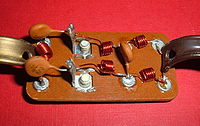This article needs additional citations for verification. (January 2021) |
A diplexer is a passive device that implements frequency-domain multiplexing. Two ports (e.g., L and H) are multiplexed onto a third port (e.g., S). The signals on ports L and H occupy disjoint frequency bands. Consequently, the signals on L and H can coexist on port S without interfering with each other.
Typically, the signal on port L will occupy a single low frequency band and the signal on port H will occupy a higher frequency band. In that situation, the diplexer consists of a lowpass filter connecting ports L and S and high pass filter connecting ports H and S. Ideally, all the lowband signal power on port L is transferred to the S port and vice versa. All the highband signal power on port H is transferred to port S and vice versa. Ideally, the separation of the signals is complete. None of the low band signal is transferred from the L port to the H port. In the real world, some power will be lost, and some signal power will leak to the wrong port.

The diplexer, being a passive device, is normally reciprocal: the device itself doesn't have a notion of input or output. However poorly designed diplexers may have differing impedance on various ports, so it should not simply be assumed that any such device is fully reciprocal unless it is stated or the return loss measured.
The diplexer is a different device than a passive combiner or splitter. The ports of a diplexer are frequency selective; the ports of a combiner are not. There is also a power "loss" difference - a combiner takes all the power delivered to the S port and equally divides it between the A and B ports. A diplexer does not.
A diplexer frequency multiplexes two ports onto one port, but more than two ports may be multiplexed. A three-port to one-port multiplexer is known as a triplexer, and a four-port to one-port multiplexer is a quadplexer or quadruplexer.
A typical diplexer may have around 30 dB isolation between its L and H ports. That isolation is sufficient for many applications, but it is insufficient to allow simultaneous reception and transmission on one antenna. If the transmitter emits 1 kW, then 1 W of that signal would appear at the receiver; that 1 W may be enough power to overload the receiver. Diplexers designed for simultaneous reception and transmission have more stringent isolation requirements and are known as duplexers.